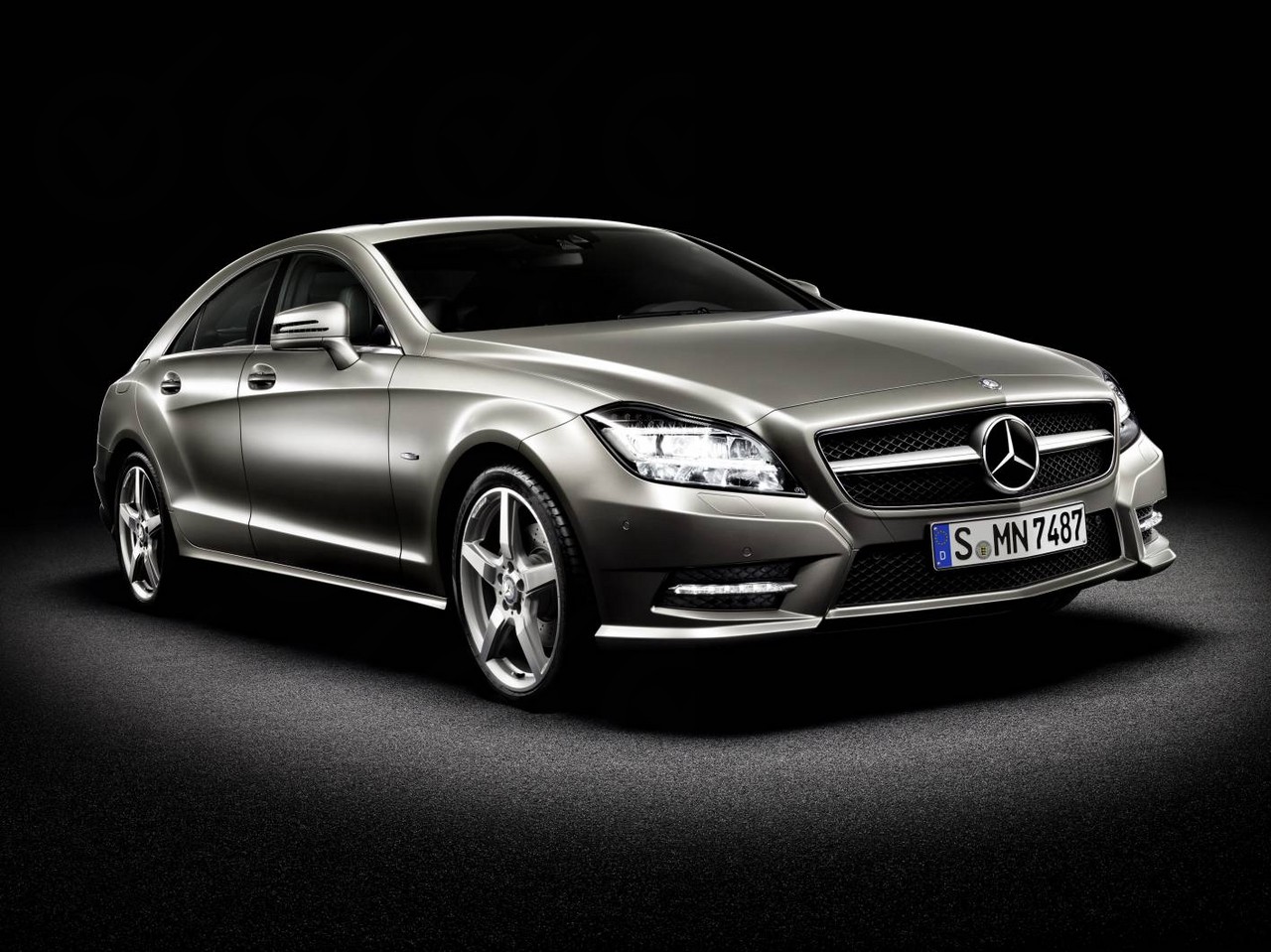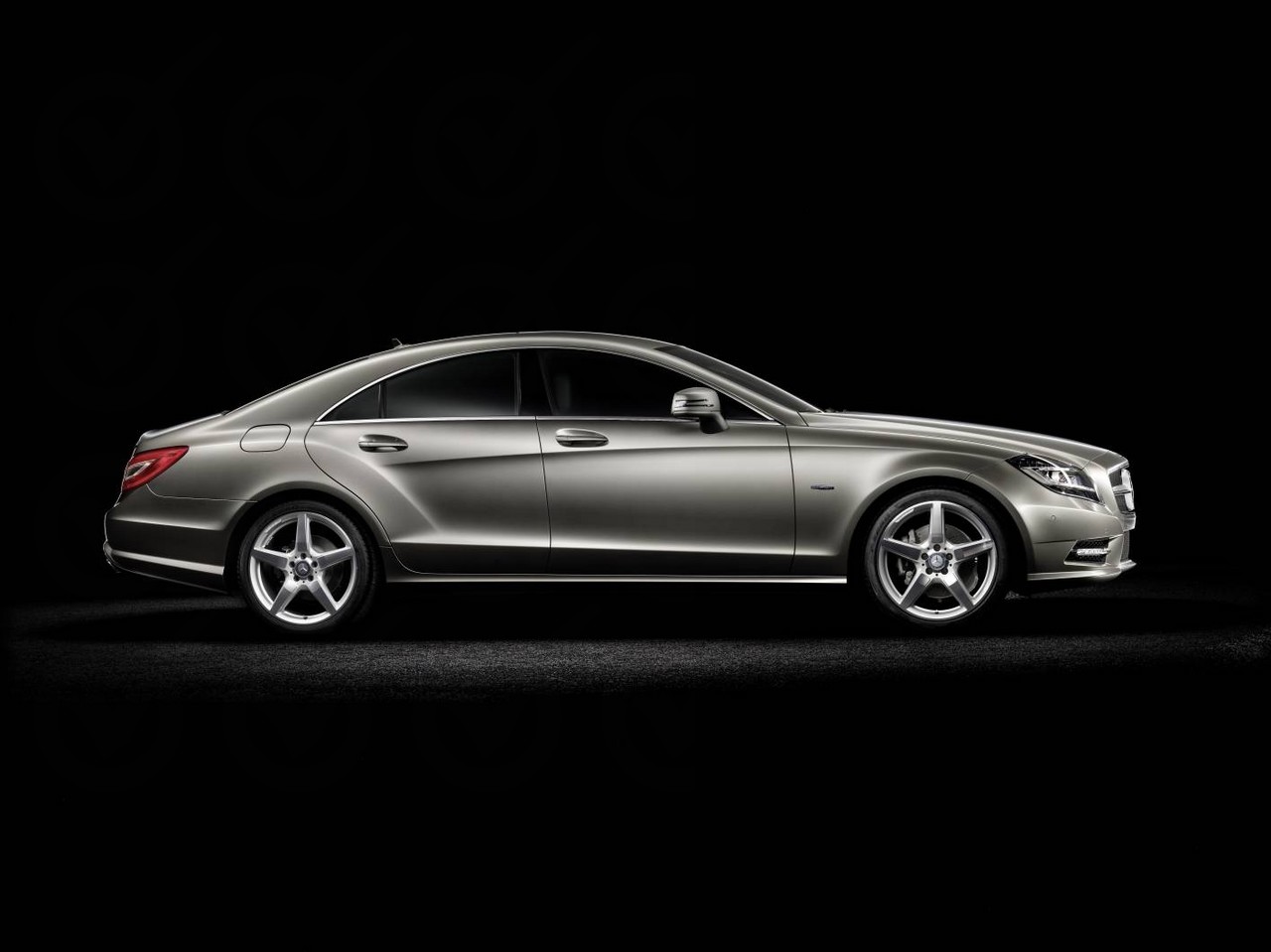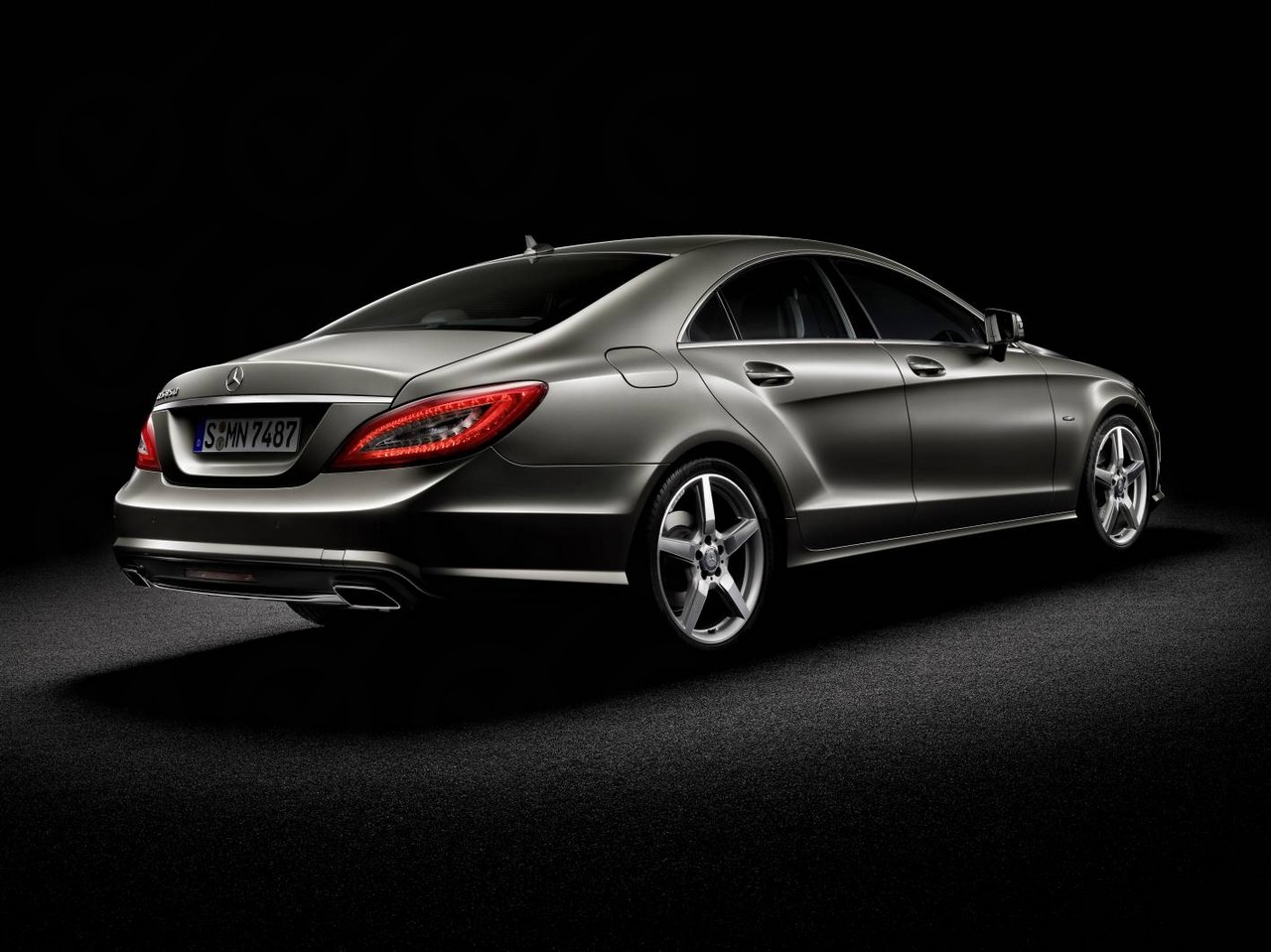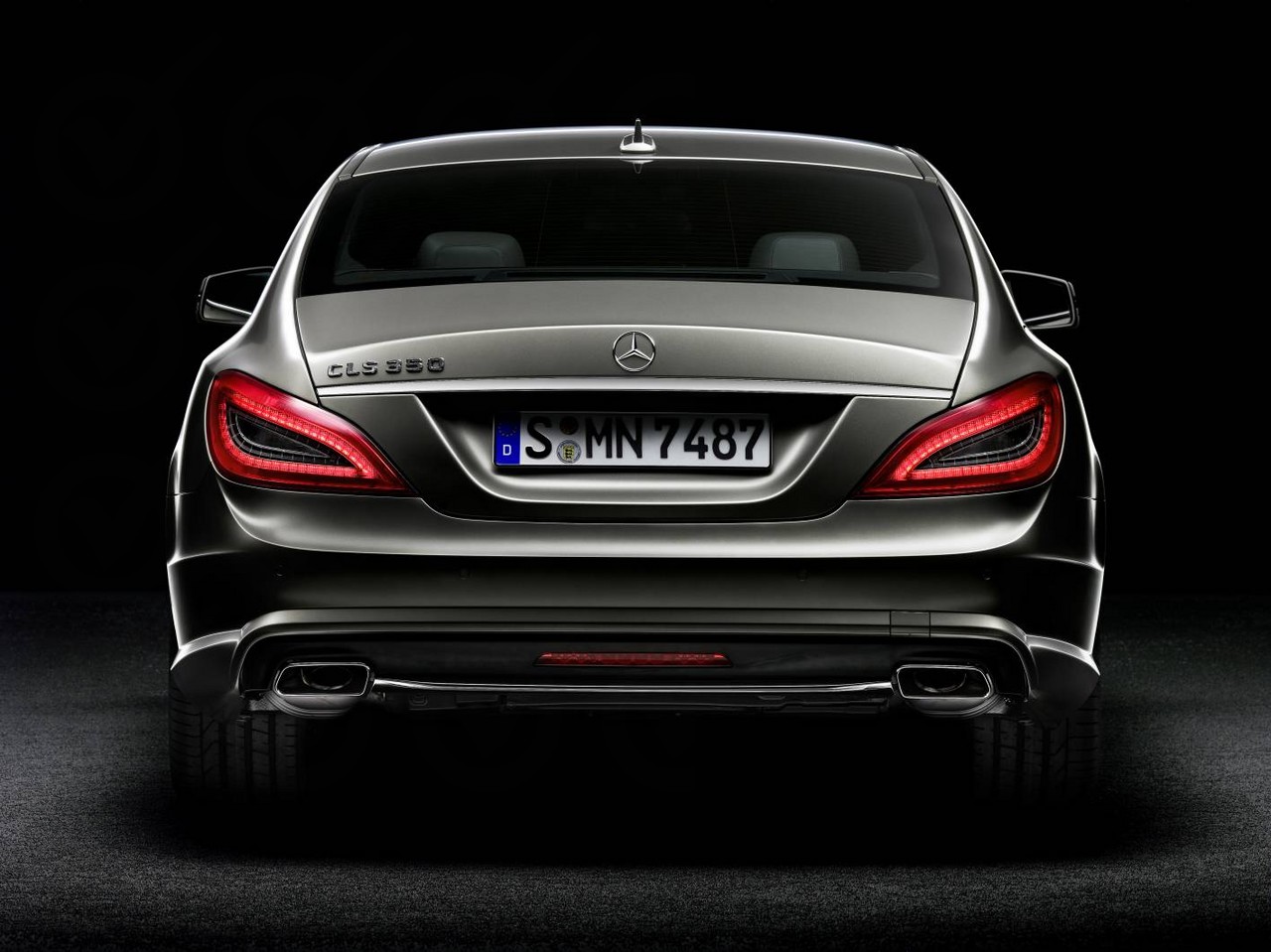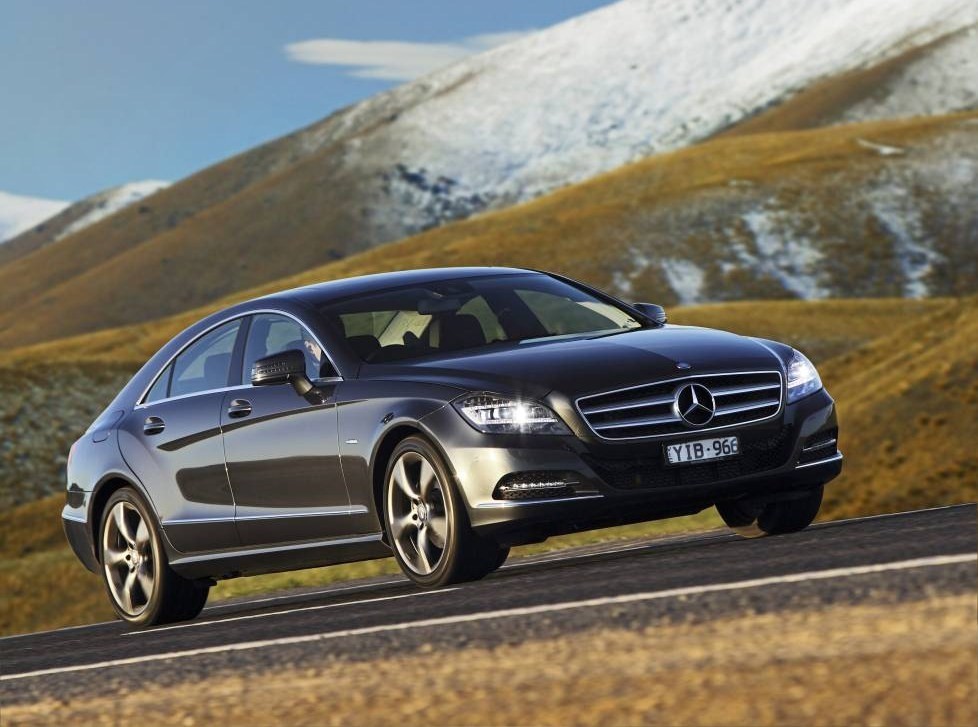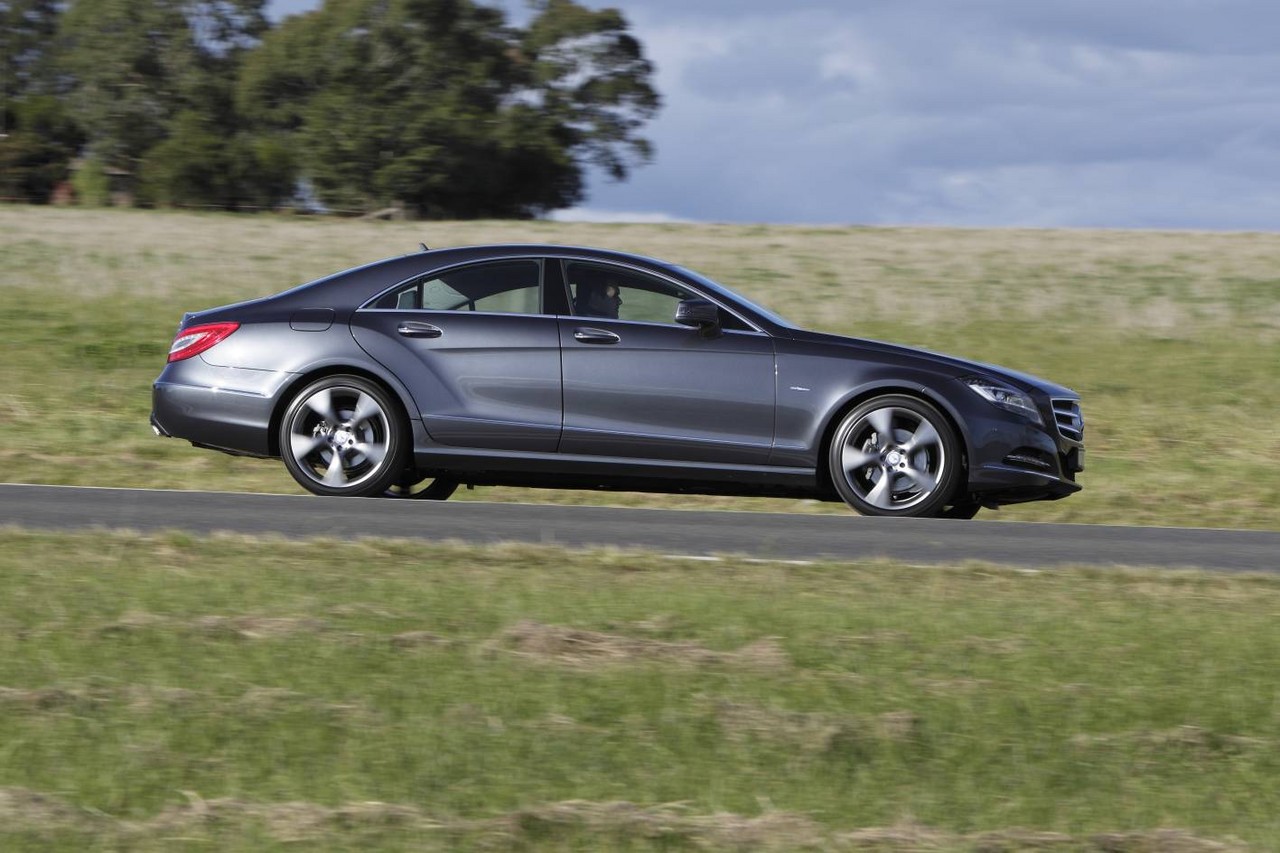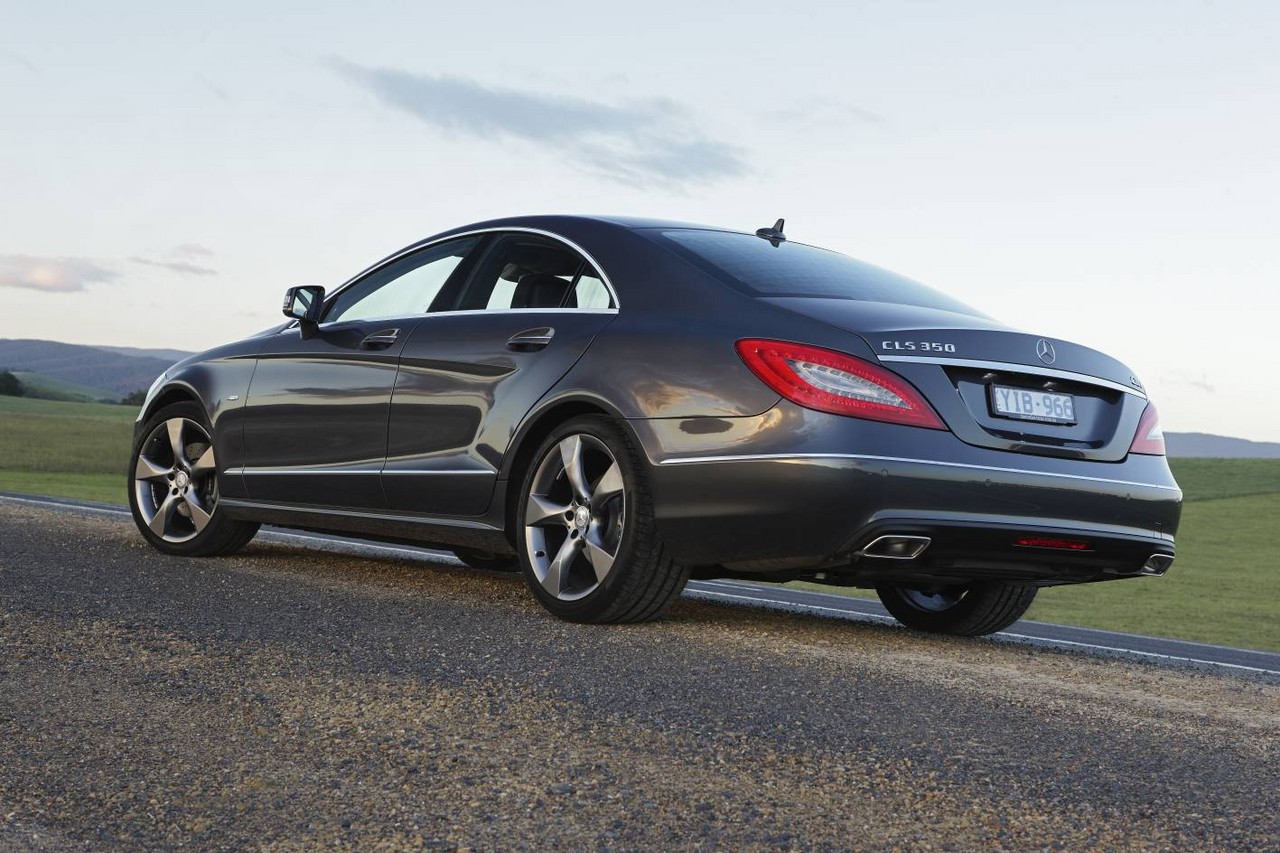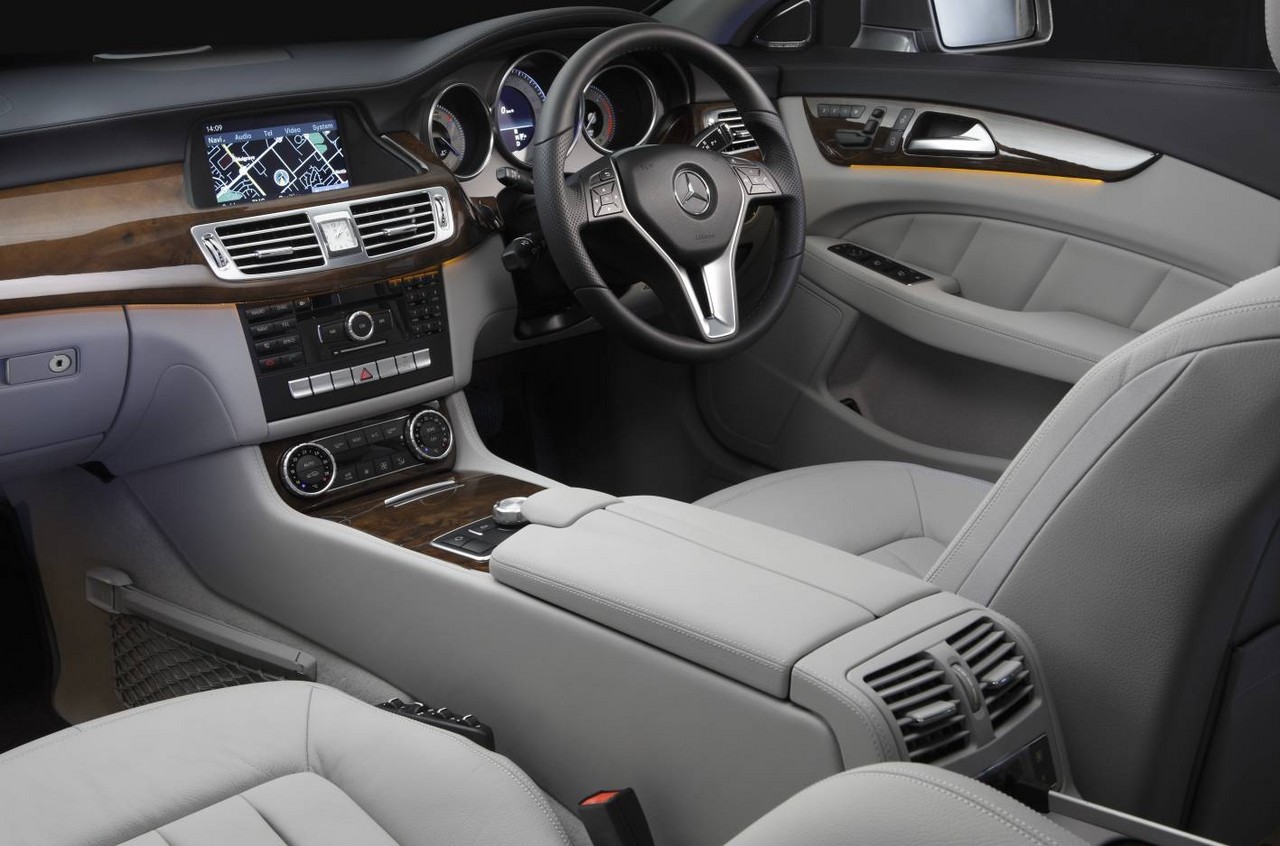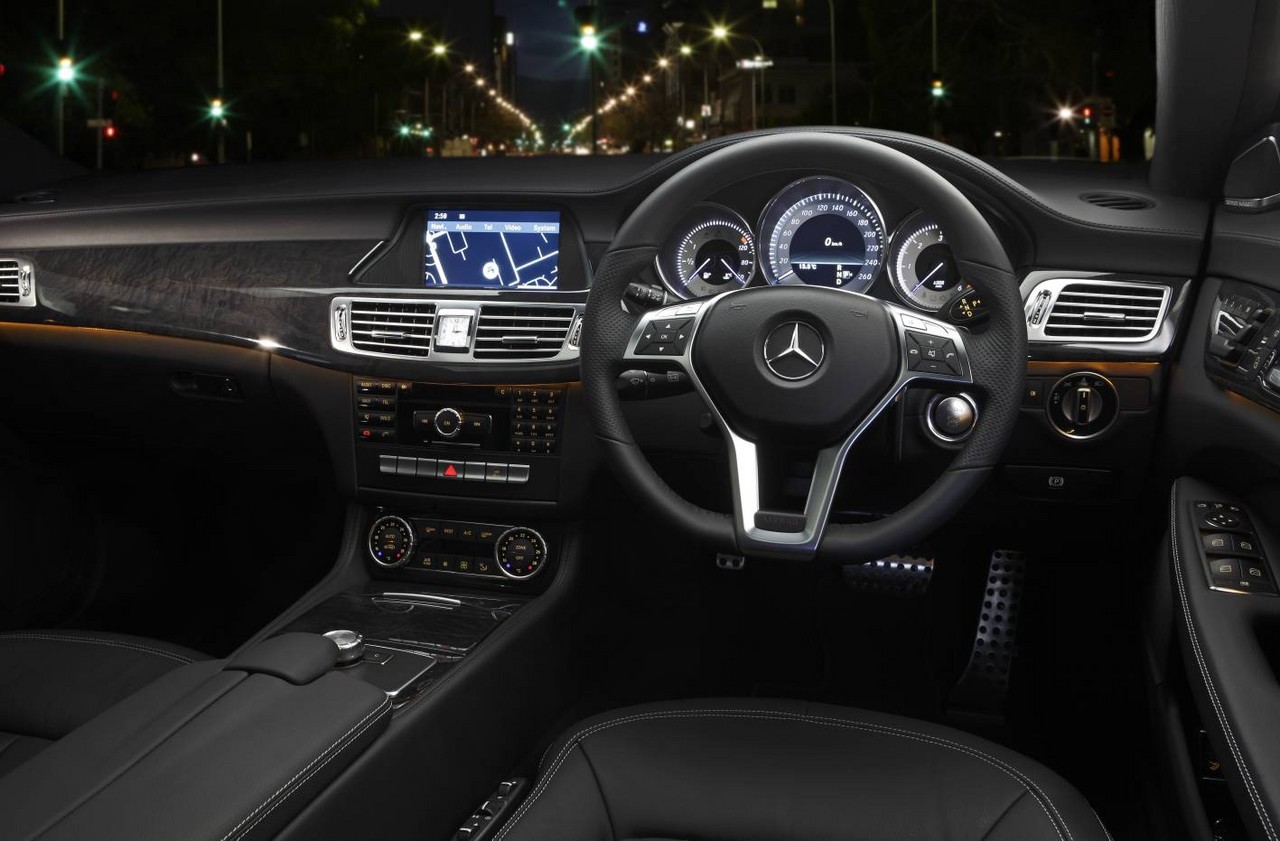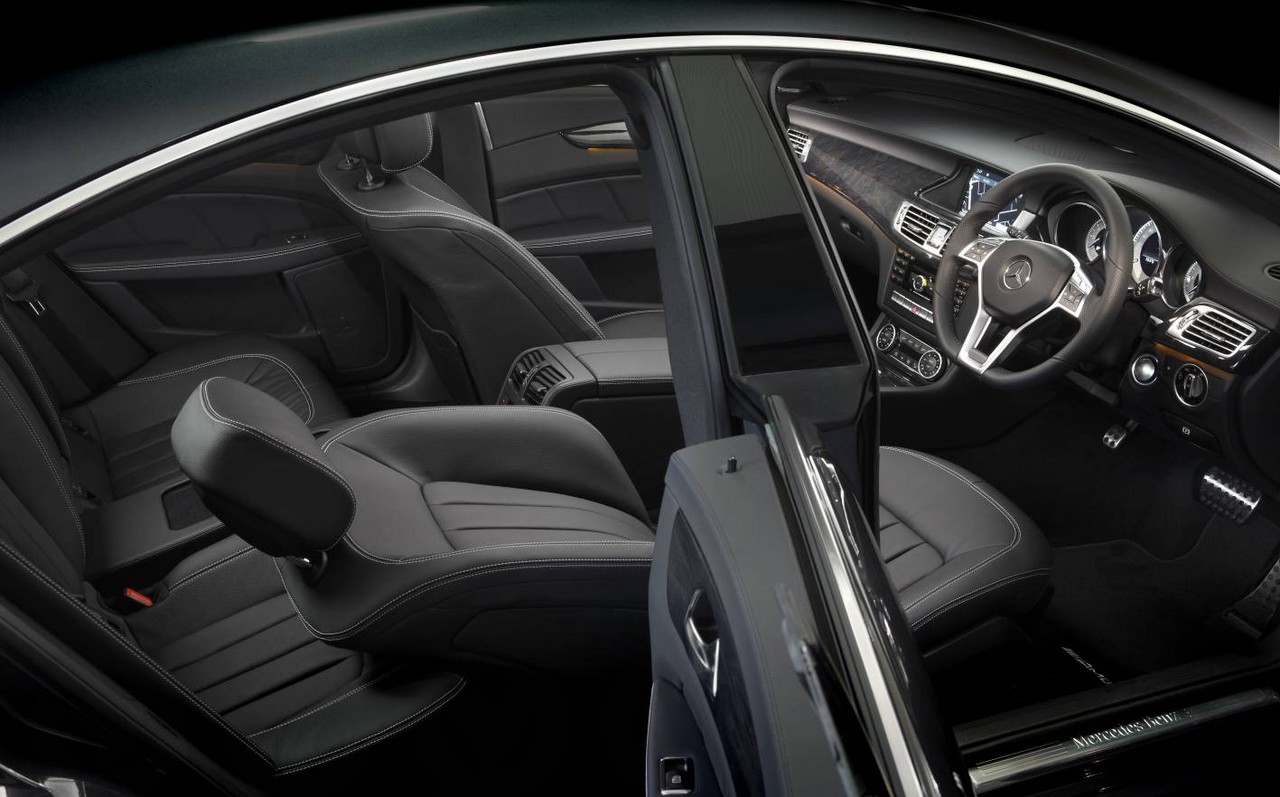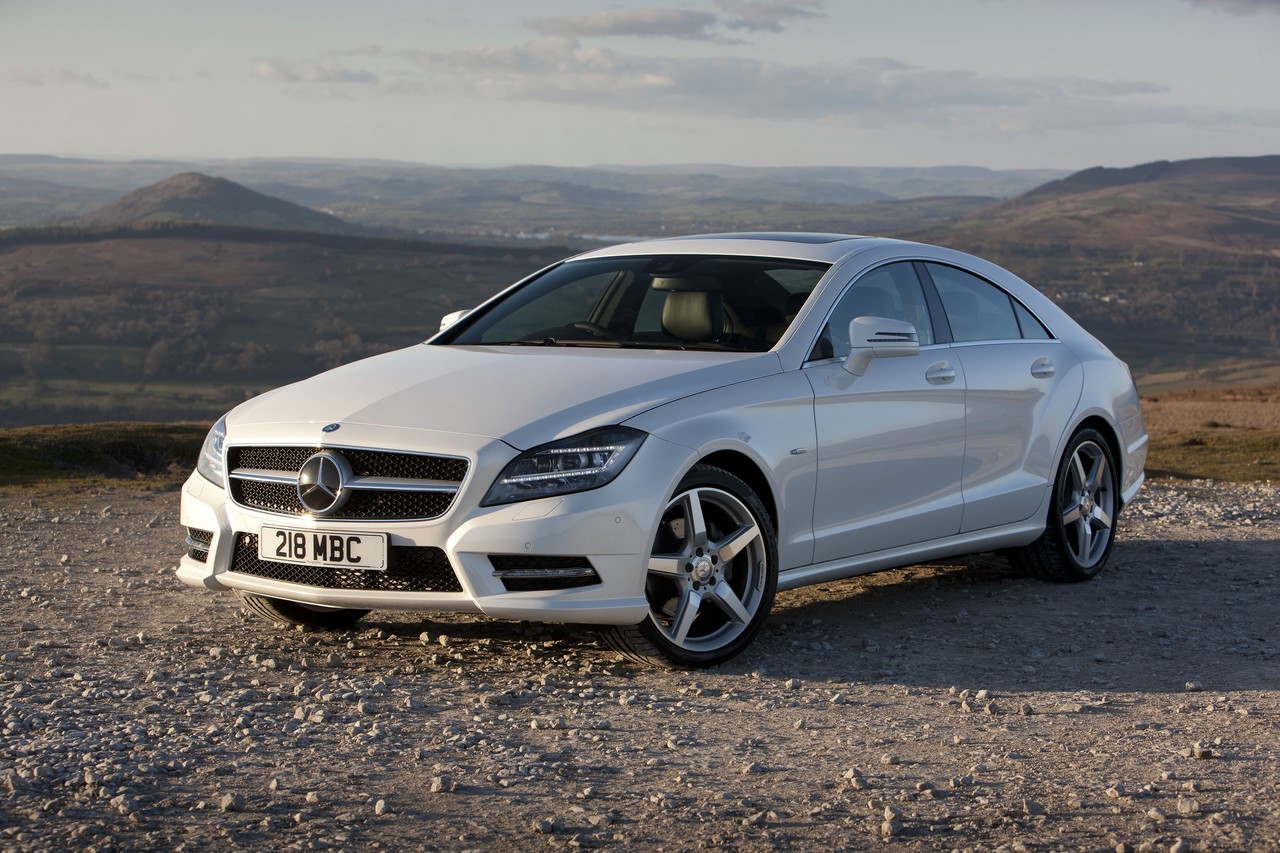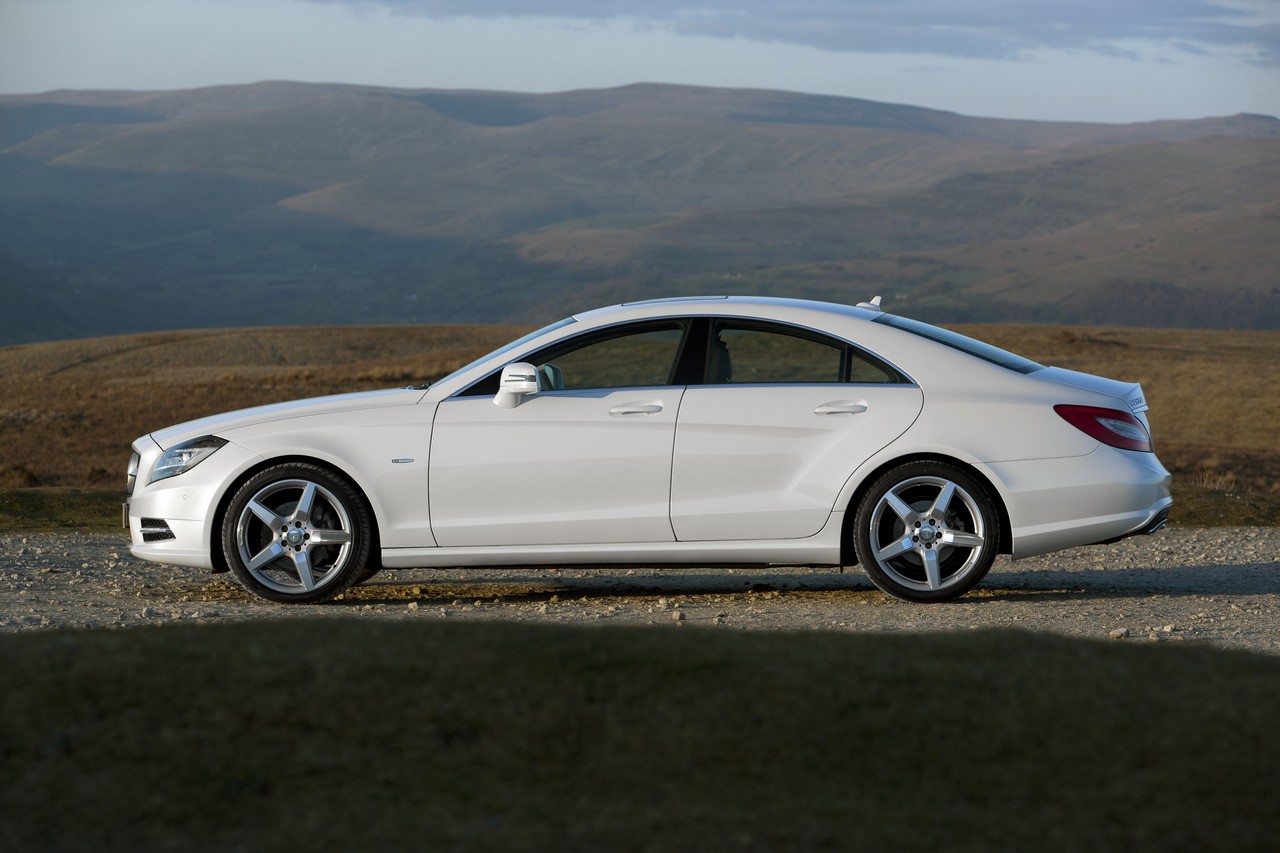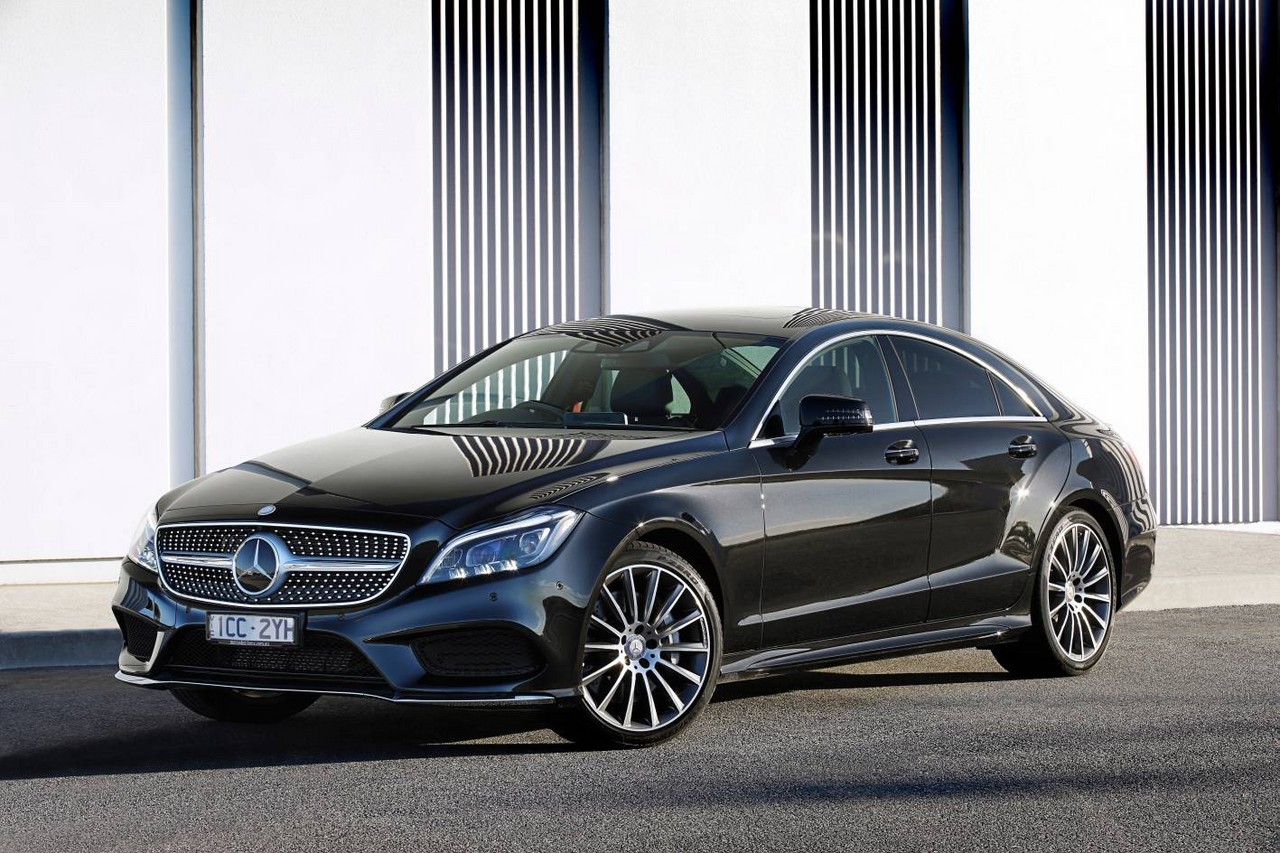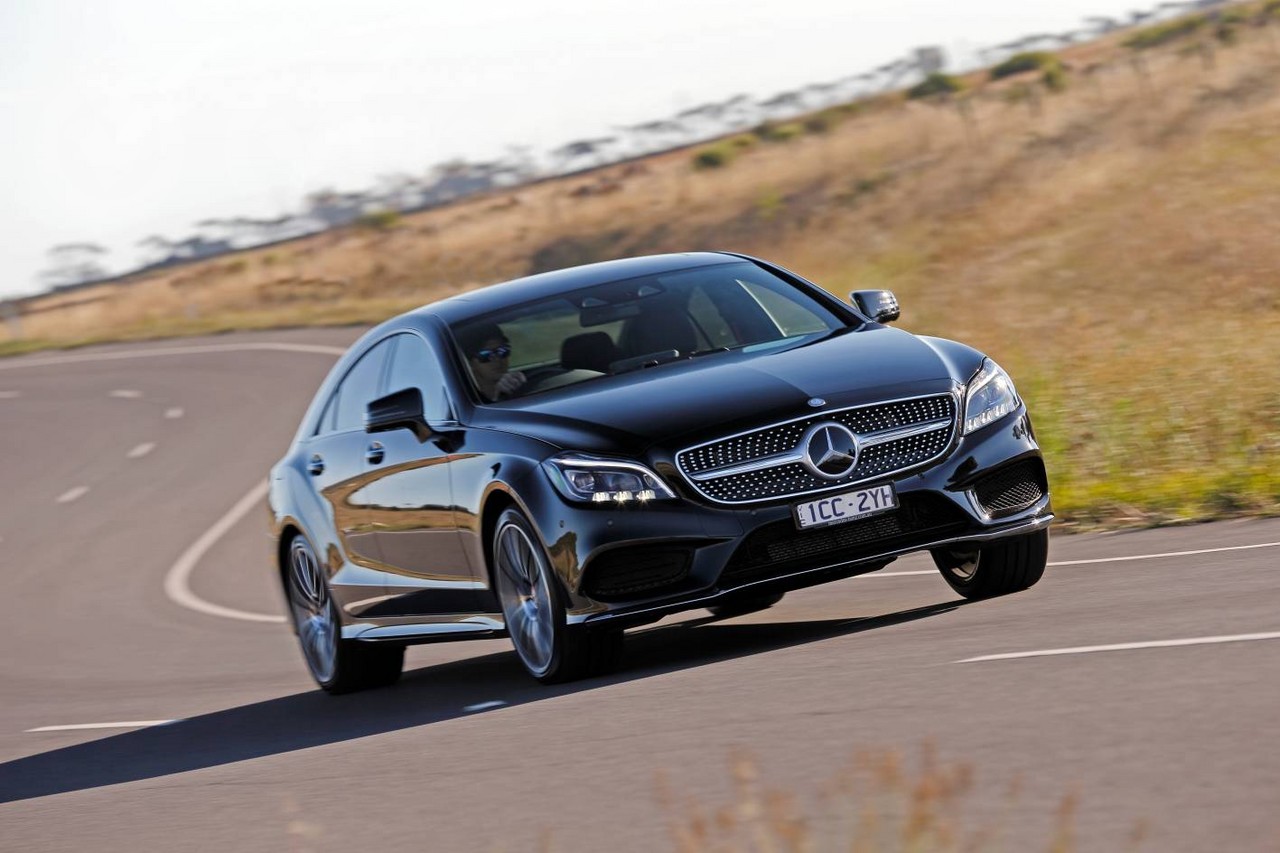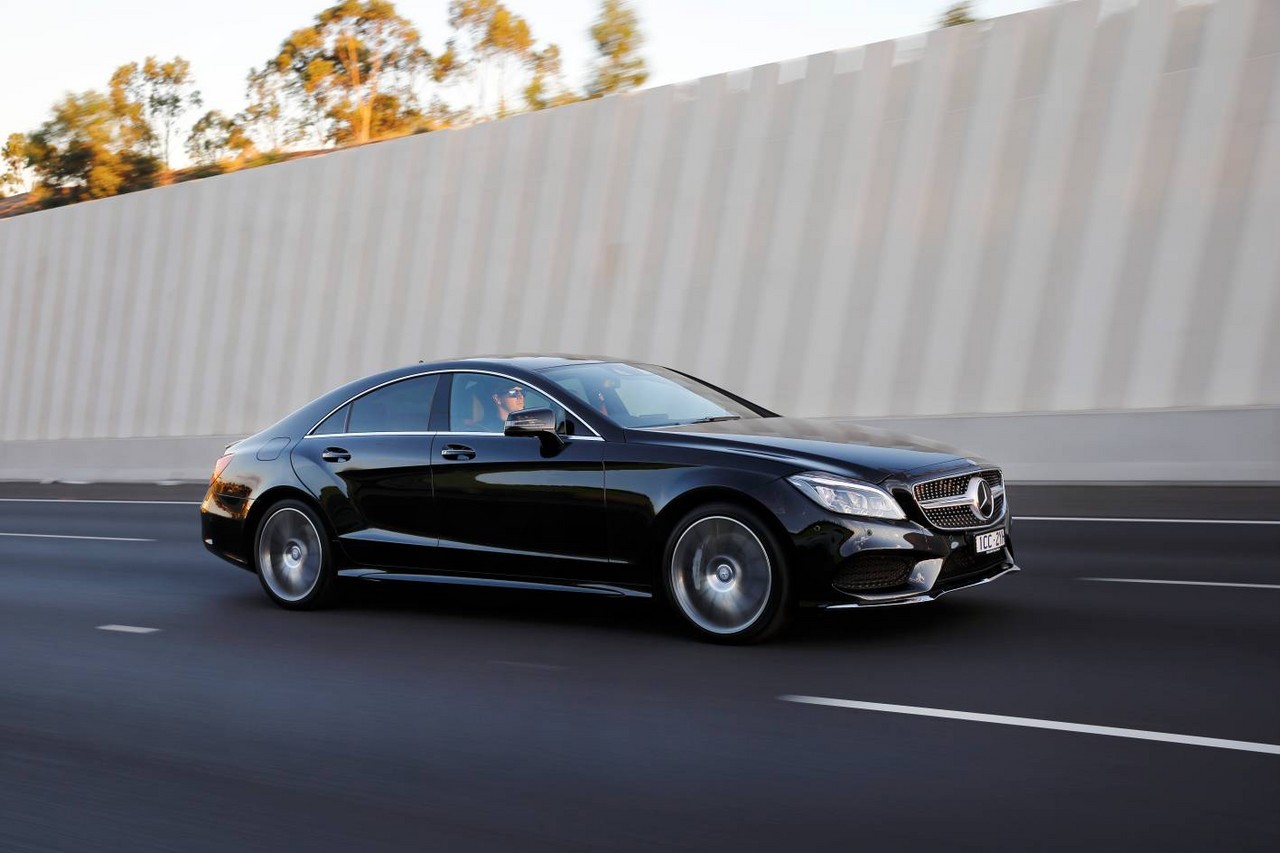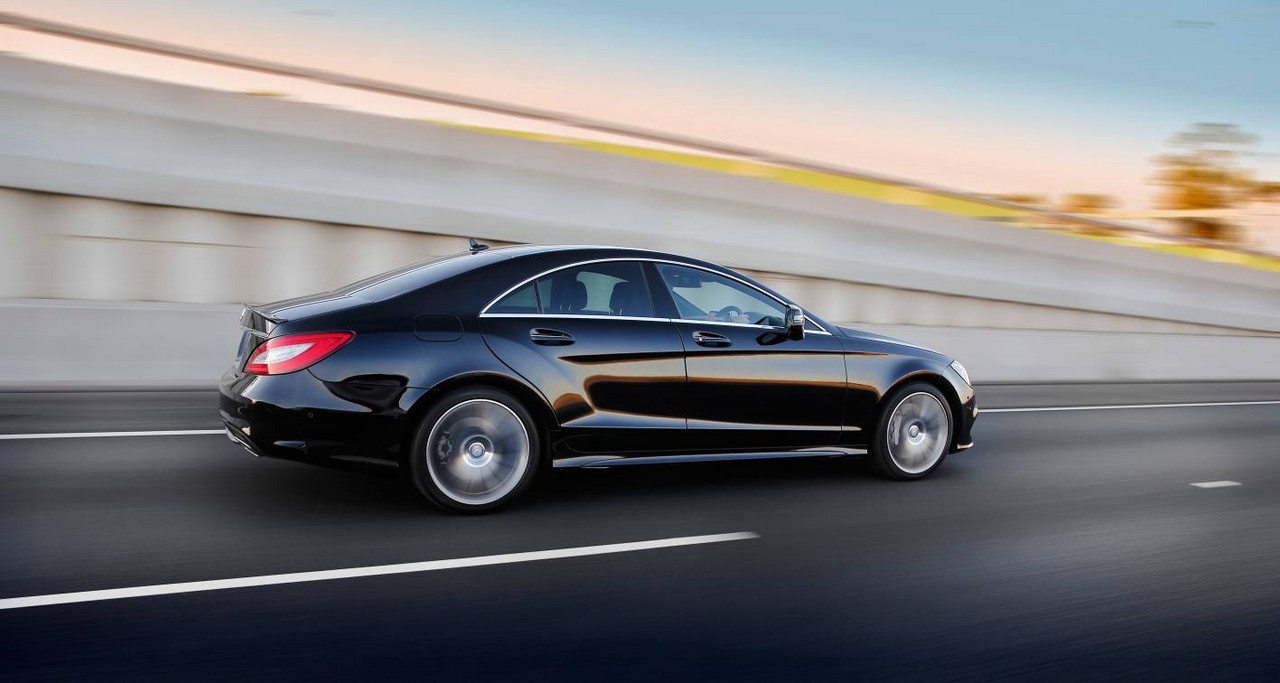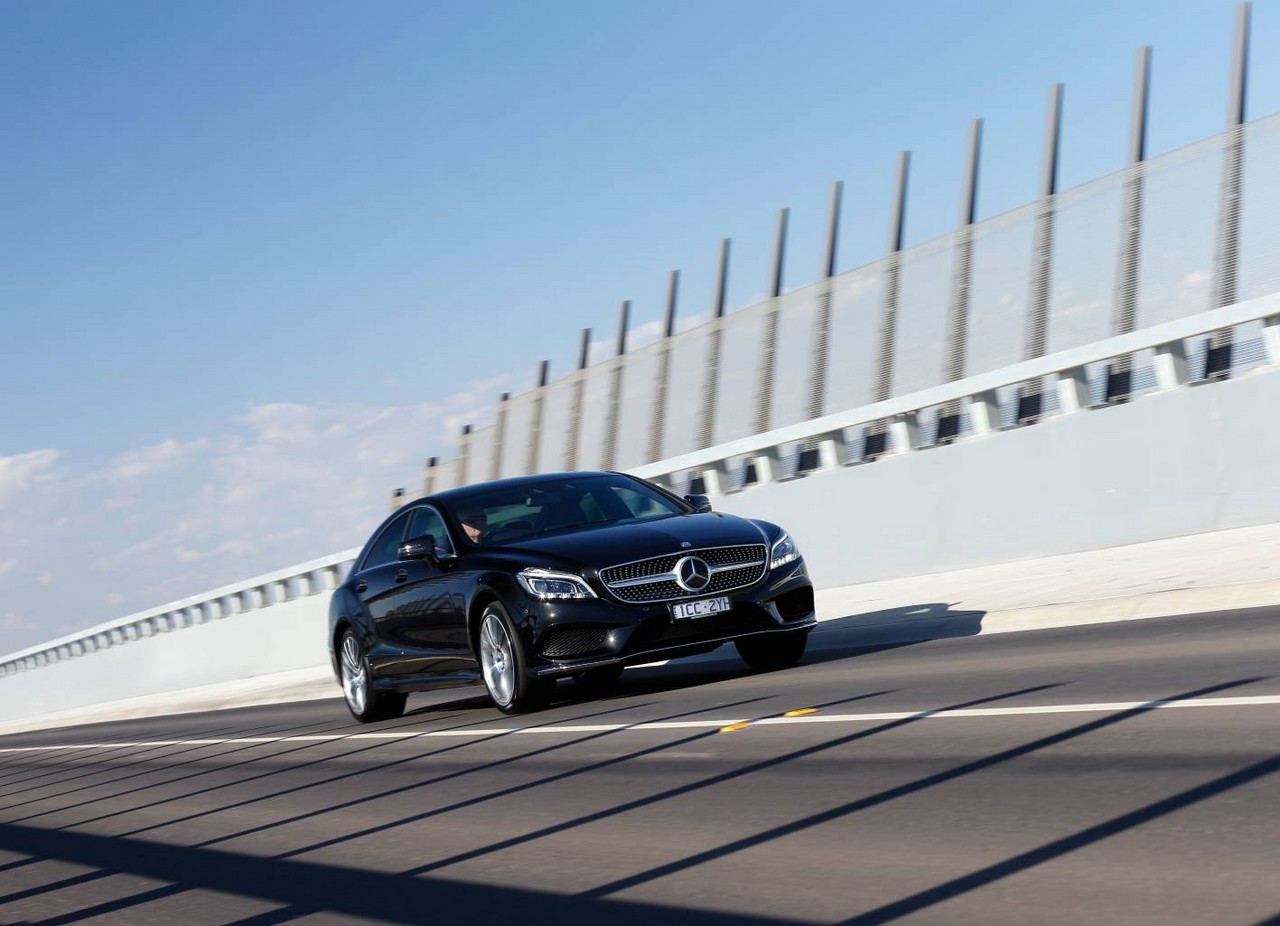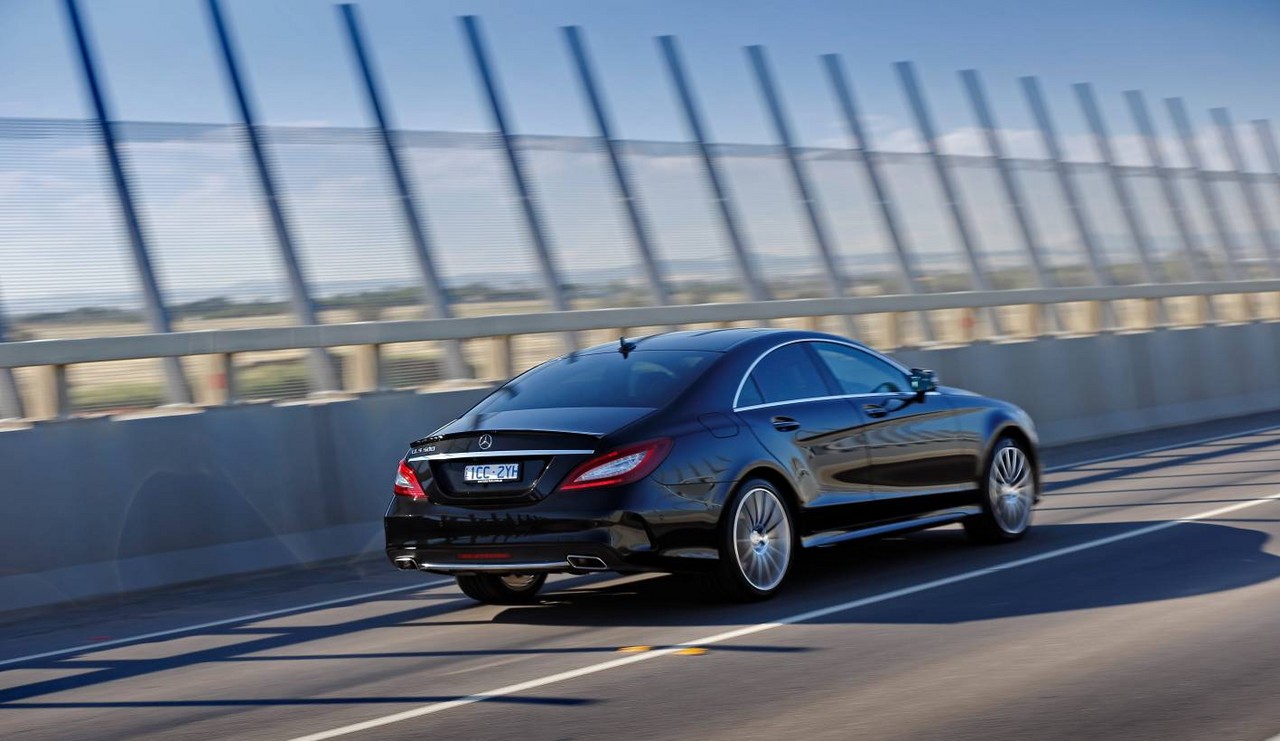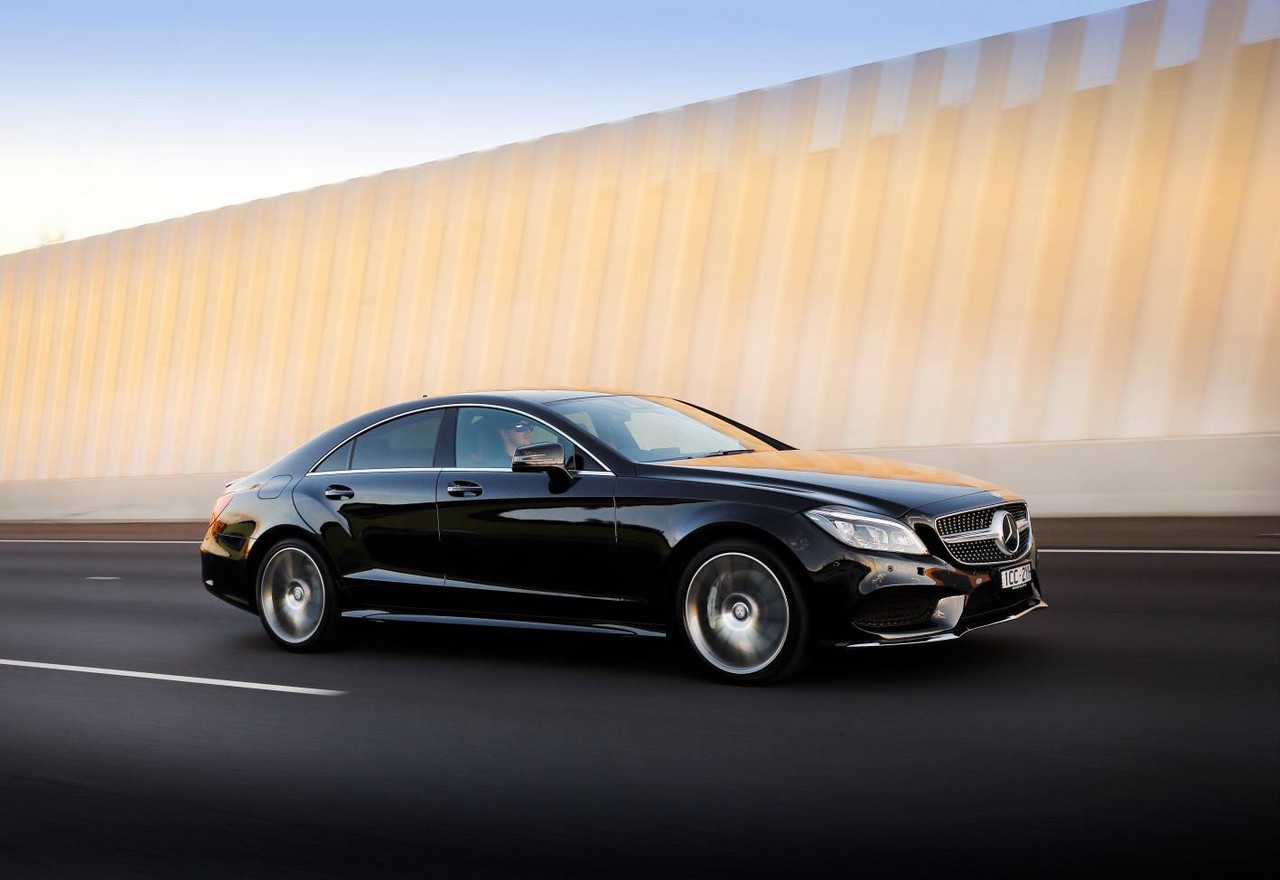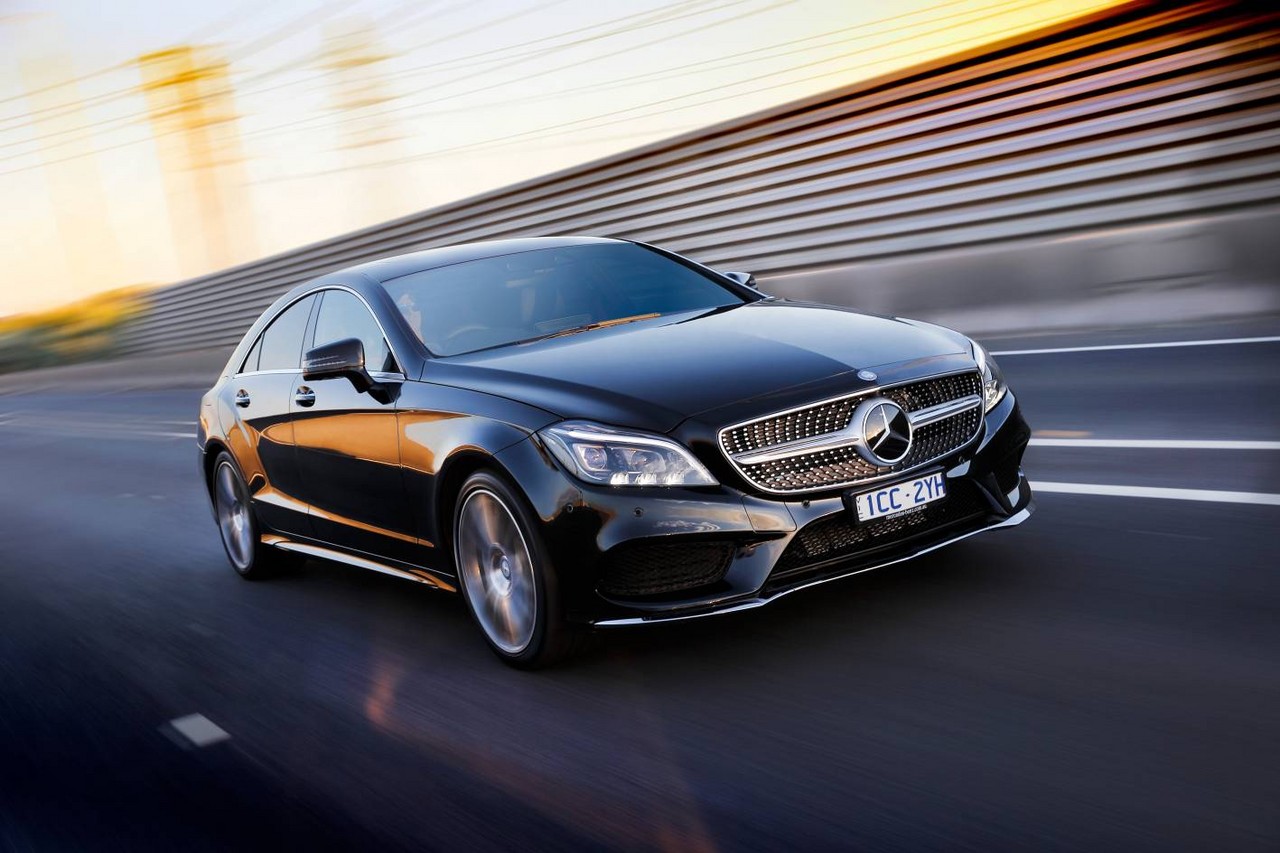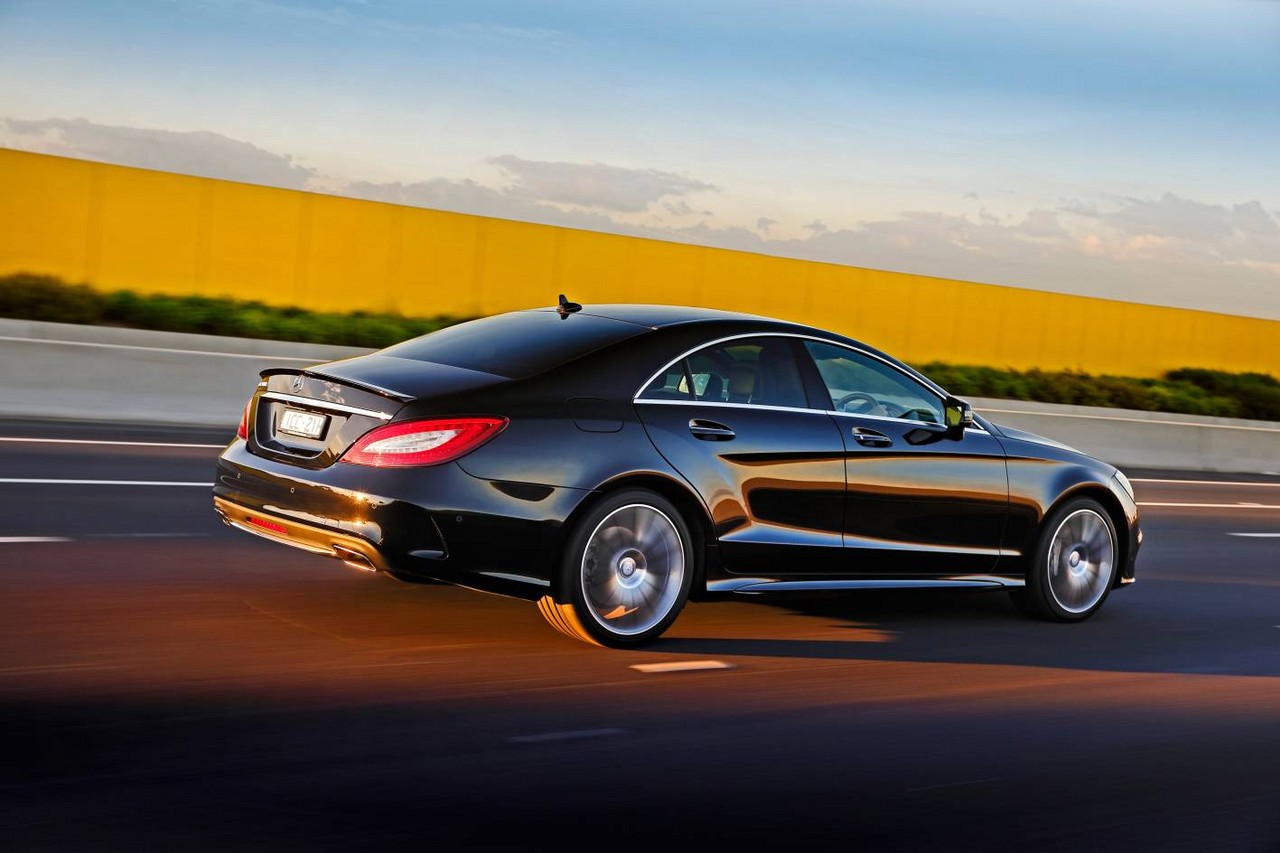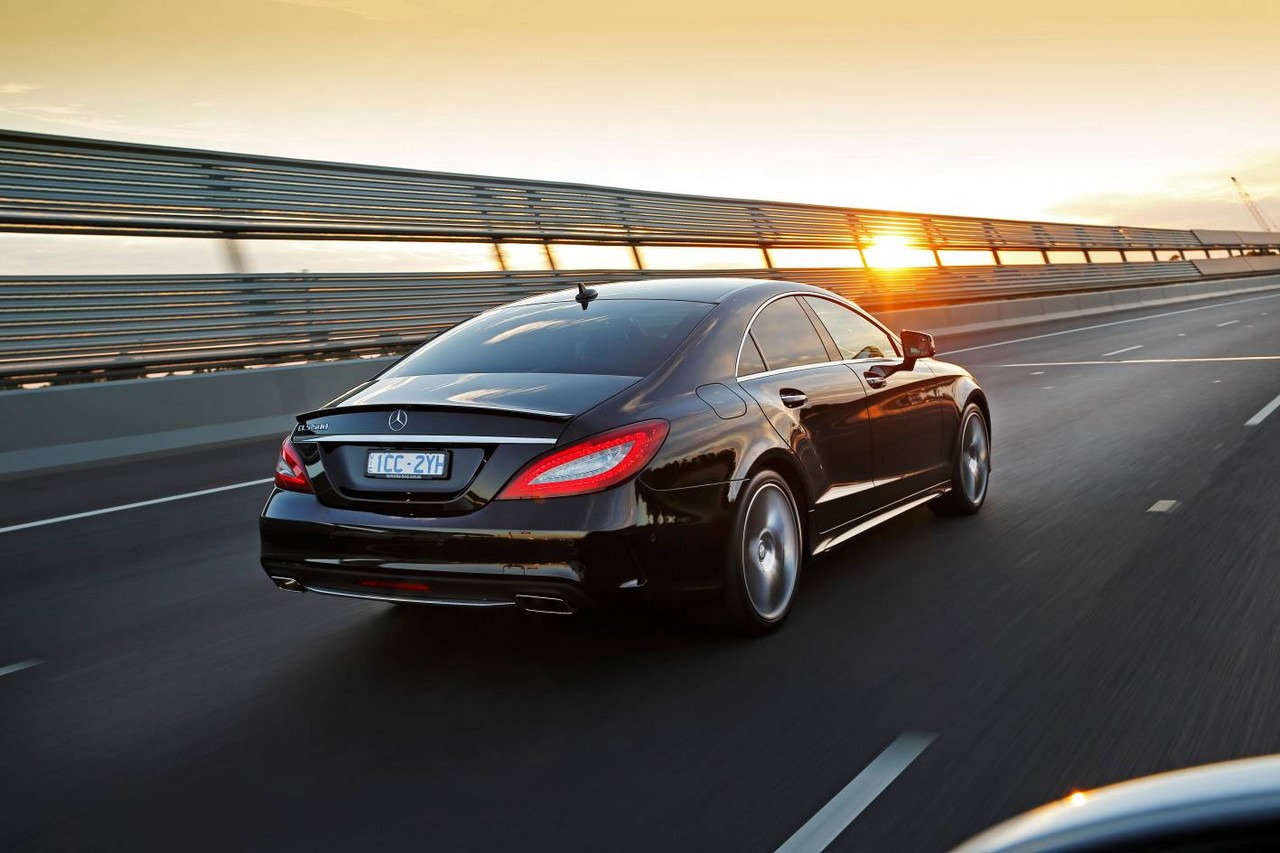
- Responsive turbo-diesel engines
- Airmatic suspension provides comfortable ride
- High standard of fit and finish
- Steering is well-weighted…
- … but lacks feel
- Limited rear seat headroom and only seats four
- Foot-operated park brake
- Poor rear visibility
Review: Mercedes-Benz C218.I CLS-Class (2011-14)
Overview
Released in June 2011, the C218 CLS-Class was a four-seat sedan with coupe-like styling. Manufactured in Sindelfingen, Germany, the rear-wheel drive CLS range initially consisted of the CLS 350 CDI BlueEfficiency, with the CLS 350 BlueEfficiency and CLS 500 BlueEfficiency following in late 2011. The CLS 250 CDI BlueEfficiency was released in September 2012.
Please note that the Mercedes C218 CLS 63 AMG has been reviewed separately.
| Years | Engine | Trans. | Peak power | Peak torque | |
|---|---|---|---|---|---|
| CLS 250 CDI | 2012-14 | 2.1-litre turbo-diesel V6 (OM651) | 7sp auto | 150 kW at 4200 rpm | 500 Nm at 1600-1800 rpm |
| CLS 350 | 2011-14 | 3.5-litre petrol V6 (M276) | 7sp auto | 225 kW at 6500 rpm | 370 Nm at 3500-5250 rpm |
| CLS 350 CDI | 2011-13 | 3.0-litre turbo-diesel V6 (OM642) | 7sp auto | 195 kW at 3800 rpm | 620 Nm at 1600-2400 rpm |
| CLS 500 | 2011-14 | 4.7-litre bi-turbo petrol V8 (M278) | 7sp auto | 300 kW at 5000-5750 rpm | 600 Nm at 1600-4750 rpm |
Body and dimensions
Compared to the Mercedes-Benz C219 CLS Class , the C218 CLS was 83 mm longer (at 4996 mm), 8 mm wider (1881 mm), 18 mm taller (1421 mm) and had a 20 mm longer wheelbase (2874 mm). Furthermore, 72 per cent of all panels for the C218 CLS-Class were made from rigid and ultra-rigid steel alloys. As a result, the bodyshell achieved a 28 per cent improvement in static flexural strength and a six per cent increase in torsional strength.
Suspension
Like the Mercedes-Benz W212 E-Class sedan on which it was based, the C218 CLS had a three-link front axle with MacPherson struts and independent, multi-link rear suspension. For the CLS 500 BlueEfficiency, the suspension included Mercedes-Benz’s ‘AIRMATIC’ air springs and electronically controlled dampers which automatically adjusted the shock absorbers to the road surface conditions.
Safety equipment
Standard safety equipment for the Mercedes-Benz C218 CLS included dual front airbags, dual front pelvis airbags, driver’s knee airbag, front and rear side airbags, full length curtain airbags, ABS, electronic brake force distribution, brake assist, electronic stability control, traction control, active front seat head restraints, driver fatigue monitoring (‘attention assist’), and seatbelts with pre-tensioners and load limiters for all seats. The C218 CLS was also fitted with ‘Pre-Safe’, which anticipated and prepared for collisions by tensioning the seatbelts, adjusting the position of the front seats for optimal airbag deployment and closing the windows and sunroof (if open).
The CLS 250 CDI, CLS 350 and CLS 350 CDI were further equipped with:
- Blind spot assist (passive): used two radar sensors in the rear of the vehicle to warn the driver before an indicated lane-change if a vehicle is in the driver’s blind spot; and,
- Lane keeping assist (passive): used a camera behind the windscreen to monitor lane markings and detect if the vehicle was drifting outside its lane. If so, acoustic and visual warnings would be issued.
The CLS 500, however, was further equipped with –
- Distronic Plus (adaptive cruise control with brake warning): an ‘adaptive’ cruise control system which used two short-range radar sensors positioned behind the front bumper to monitor the road up to 30 metres ahead, and a long-range radar located behind the radiator grille which had a range of 200 metres. Operating at speeds up to 200 km/h, Distronic Plus used an electronic control unit to analyse the information from both radar systems to calculate the engine, automatic transmission and braking parameters required for proximity control. As such, Distronic Plus could automatically apply the brakes to prevent the vehicle from becoming too close to traffic ahead (the time interval could be specified) and accelerate back to the set speed when traffic allowed. To accelerate from rest, the driver only needed to operate the Distronic stalk on the steering column or briefly depress the accelerator pedal. With Distronic Plus, automatic deceleration of up to four (4) m/s2was possible. If Distronic Plus detected that heavier braking was required, a warning light would illuminate in the instrument cluster and be accompanied by an audible warning. Furthermore, the electronic proximity control system could be activated independently of Distronic Plus at speeds over 30 km/h to alert the driver if they were approaching another vehicle too rapidly;
- Pre-Safe Brake (autonomous emergency braking): using two 24 GHz sensors behind the front bumper which had a range of 30 metres and a 77 GHz radar which had a range of 200 metres, Pre-Safe Brake operated at speeds between 30 km/h and 200 km/h, and at speeds below 70 km/h if the vehicle was approaching a stationary queue of traffic. Around 2.6 seconds before the anticipated moment of impact, an audible warning would sound and a red warning would appear in the tachometer. Around 1.6 before the calculated impact, the first stage of Pre-Safe Brake would initiate partial braking autonomously with around 40 per cent of the maximum braking power (approximately four (4) m/s2); the Pre-Safe occupant protections system would also be activated. If the driver then applied the brakes, maximum braking force would be made available. If the driver failed to react, Pre-Safe Brake would – in its second stage – initiate autonomous emergency braking (i.e. maximum braking power) around 0.6 seconds before the unavoidable collision to reduce the severity of the impact;
- Active Blind Spot Assist: automated braking of wheels on one side of the vehicle to prevent collisions with objects in the driver’s blind spot; and,
- Active Lane Keeping Assist: automated braking of wheels on one side of the vehicle to keep the vehicle within continuous lane markings.
Features: Mercedes-Benz CLS 250
Standard features for the Mercedes-Benz CLS 250 CDI BlueEfficiency included 18-inch five-spoke alloy wheels, COMAND APS (Cockpit Management and Data System) with a seven-inch colour display, six-disc CD/DVD changer, MP3/WMA/AAC compatibility, auxiliary inputs (3.5mm/USB/iPod integration), Bluetooth connectivity, voice recognition (‘Linguatronic’), a 10GB hard drive and HDD satellite navigation, climate control air conditioning, power adjustable front seats, leather upholstery, cruise control with variable speed limiter (‘SPEEDTRONIC’), front fog lights, a reversing camera, front and rear parking sensors, automated parallel parking ‘Active Parking Assist’), a nappa leather-wrapped steering wheel with gearshift paddles, remote central locking, power windows and heated mirrors, power folding mirrors, a power adjustable steering column (height and reach), memory settings (front seats, mirrors and steering wheel), a power-operated glass sunroof with tilt/slide function, an automatically dimming interior rear view mirror, ambient lighting, burr walnut wood trim, 12 volt power outlets, tyre pressure monitoring, a trip computer and an immobiliser.
Features: Mercedes-Benz CLS 350 and CLS 350 CDI
Compared to the CLS 250 CDI, the CLS 350 BlueEfficiency and CLS 350 CDI BlueEfficiency added a fourteen speaker Harman Kardon Logic7 surround sound system with digital radio (DAB+), multi-contour front seats with inflatable air chambers, three-zone climate control air conditioning (‘Thermotronic’), full-LED headlights and a TV tuner.
Features: Mercedes-Benz CLS 500
The Mercedes-Benz CLS 500 BlueEfficiency was distinguished by its 19-inch five-spoke alloy wheels, ventilated and heated ‘luxury’ front seats, keyless go, power-operated rear window blind, brushed stainless steel sports pedals, a wood/leather steering wheel, motion-sensing alarm and AMG front and rear aprons.
Mercedes-Benz CLS 250 CDI and CLS 500: Avantgarde 10 Editions
In January 2014, Mercedes-Benz commemorated the tenth anniversary of the CLS-Class by announcing limited-run CLS 250 CDI and CLS 500 Avantgarde 10 Editions. Compared to its standard counterpart, the CLS 250 CDI Avantgarde 10 Edition was fitted with 19-inch alloy wheels, electronically controlled dampers (‘Airmatic’), LED headlights and AMG bodystyling. Inside, the Avantgarde 10 Editions featured a Harman Kardon Logic 7 surround sound system and heated front seats. Beyond this, the CLS 500 Avantgarde 10 Edition added digital (DAB+) radio reception and ‘Easy-Pack Quick fold’ rear seats.
Brochure
Related links
- Press Kit: Mercedes-Benz C218 CLS (October 2010)
- Specifications: Mercedes-Benz C218 CLS Coupe (April 2013)
- Specifications: Mercedes-Benz C218 CLS Coupe (February 2014)
Review: Mercedes-Benz C218.II CLS-Class (2014-17)
Overview
Released in October 2014, the Mercedes-Benz C218 Series II (C218.II) CLS introduced a revised range as:
- the CLS 350 was replaced by the bi-turbo CLS 400;
- the CLS 500 was fitted with a nine-speed automatic transmission (Mercedes-Benz’s ‘9G-Tronic’); and,
- the CLS 350 CDI was discontinued.
Mercedes-Benz’s ‘Airmatic’ electronically-controlled dampers were also fitted as standard for the CLS 250 CDI, CLS 400 and CLS 500 (previously limited to the CLS 500).
Visually, the Mercedes-Benz C218.II CLS-Class could be identified by its new diamond radiator grille, pronounced front bumper with large air intakes, multi-beam LED headlights (fitted as standard) and darkened tail-lights with multi-level functionality. Inside, the CLS featured a new 21.3 cm free-standing colour display and a redesigned three-spoke sports steering wheel. Standard features were also extended to include a 360 degree camera.
| Years | Engine | Trans. | Peak power | Peak torque | |
|---|---|---|---|---|---|
| CLS 250 CDI | 2014-17 | 2.1-litre turbo-diesel V6 (OM651) | 7sp auto | 150 kW at 4200 rpm | 500 Nm at 1600-1800 rpm |
| CLS 400 | 2014-17 | 3.0-litre bi-turbo petrol V6 (M276) | 7sp auto | 245 kW at 5250-6000 rpm | 480 Nm at 1200-4000 rpm |
| CLS 500 | 2014-17 | 4.7-litre bi-turbo petrol V8 (M278) | 9sp auto | 300 kW at 5000-5750 rpm | 600 Nm at 1600-4750 rpm |
Safety equipment
Previously limited to the CLS 500, standard safety equipment was extended to include:
- Distronic Plus (explained above);
- Pre-Safe Brake (explained above);
- Active Blind Spot Assist: automated braking of wheels on one side of the vehicle to prevent collisions with objects in the driver’s blind spot; and,
- Active Lane Keeping Assist: automated braking of wheels on one side of the vehicle to keep the vehicle within continuous lane markings.
Also fitted as standard was ‘Pre-Safe Plus’ which, if an impending rear impact was anticipated, would warn following traffic by flashing the rear brake lights. Pre-Safe Plus could also lock the brakes if the vehicle was stationary to reduce forward jolt on impact; Pre-Safe would also be activated immediately prior to impact.
Features: Mercedes-Benz C218.II CLS 250
Standard features for the Mercedes-Benz CLS 250 CDI included 19-inch alloy wheels, a Harman Kardon Logic7 surround sound system, DAB+ digital radio, a CD/DVD player and 10GB music register, COMAND Online with a 21.3 cm TFT colour display, HDD navigation with traffic updates, Linguatronic voice recognition, internet access, Bluetooth mobile phone connectivity and audio streaming, climate control air conditioning, power adjustable and heated front seats, leather upholstery, cruise control, multi-beam LED headlights, a 360 degree surround view camera, front and rear parking sensors, automated parallel parking (‘Active Parking Assist’), a nappa leather steering wheel with gearshift paddles, remote central locking with proximity key, power adjustable and folding door mirrors with heating, power windows, push-button start, a TFT instrument panel, driver memory settings, a glass sunroof, three 12 volt power sockets, electrochromatic rear view and door mirrors, tyre pressure monitoring, ambient lighting, velour floor mats, illuminated front door sills, black ash high-gloss wood trim, a trip computer and an immobiliser.
Features: Mercedes-Benz C218.II CLS 400
The Mercedes-Benz C218.II CLS 400 was further equipped with ‘Passion’ nappa leather upholstery, multi-contour front seats and a combination nappa leather/wood steering wheel.
Features: Mercedes-Benz C218.II CLS 500
Beyond this, the Mercedes-Benz CLS 500 featured a digital TV tuner, three-zone climate control air conditioning, ‘Exclusive Passion’ leather upholstery, ‘Active’ multi-contour front seats, ‘Climatised’ ventilated front seats, a powered sunblind for the rear window and an anti-theft system.
Visually, the CLS 500 could be identified by its AMG bodystyling and single-louvre diamond radiator grille with chrome pins.
Brochure
Related links
- Specifications: Mercedes-Benz C218 CLS (December 2014)
- Mercedes-Benz Australia: Mercedes-Benz CLS-Class
- Wikipedia.org: Mercedes-Benz C218 CLS-Class
